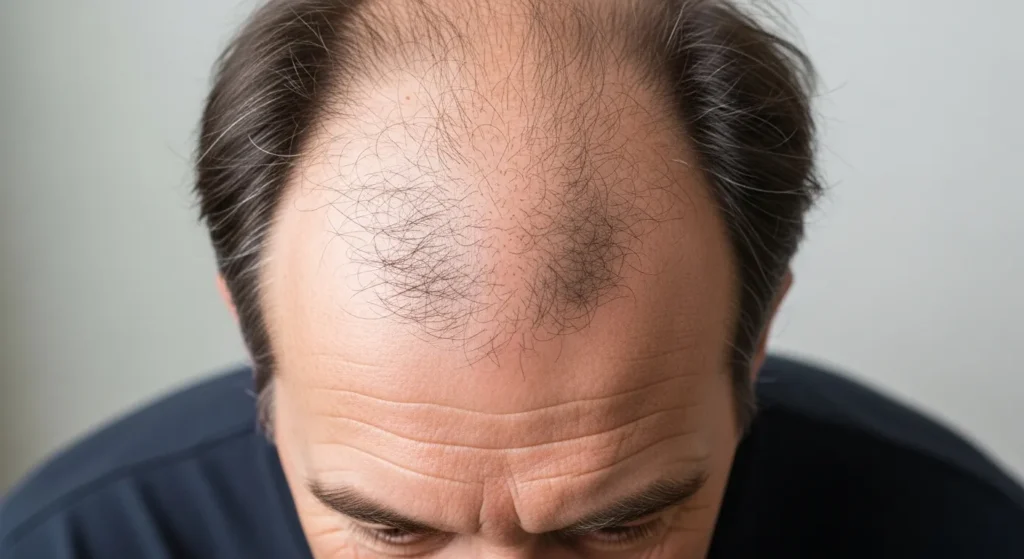Hair loss can be emotionally and financially overwhelming, especially when you’re unsure whether insurance will help offset treatment costs. Hair loss insurance coverage depends on many factors, including the cause, treatment type, and insurance provider policies.
This guide breaks down what’s typically covered, how to boost your chances of approval, and expert advice to help you navigate insurance claims with confidence. Whether you’re facing medical hair loss or seeking cosmetic solutions, we’re here to help you make informed decisions.
Understanding Hair Loss and Its Causes

Hair loss, medically known as alopecia, can stem from a wide variety of causes—some temporary and others more permanent. Understanding the root cause is crucial when it comes to qualifying for insurance coverage.
Common Medical and Non-Medical Causes of Hair Loss
- Medical causes: Autoimmune diseases (like alopecia areata), thyroid disorders, anemia, chemotherapy, and lupus.
- Non-medical causes: Stress, age-related thinning, traction alopecia from tight hairstyles, or poor nutrition.
When Is Hair Loss Considered a Medical Condition?
Hair loss is more likely to be viewed as medically necessary if it results from:
- Chemotherapy or radiation
- Autoimmune disorders (e.g., alopecia areata)
- Endocrine conditions (like PCOS or hypothyroidism)
In such cases, a formal diagnosis from a dermatologist or trichologist can support insurance claims.
Types of Hair Loss Treatments
- Medical: Finasteride, minoxidil, corticosteroid injections
- Surgical: FUE/FUT hair transplant (usually cosmetic)
- Regenerative: PRP (platelet-rich plasma) therapy
- Supportive: Scalp prostheses (medical wigs), microneedling, laser therapy
Hair Loss Insurance Coverage Explained
Not all hair loss treatments are considered “medically necessary,” which is the threshold most insurers require for coverage. Let’s break it down.
What Types of Treatments Are Typically Covered?
Insurance might cover:
- Treatments for medically diagnosed conditions
- Prescription medications (e.g., finasteride for androgenetic alopecia)
- Cranial prostheses for chemotherapy patients
Cosmetic vs Medically Necessary Treatments
Most hair transplants, PRP therapies, and over-the-counter products are classified as cosmetic and thus not covered. However, if hair loss results from a disease or therapy, insurance is more likely to assist.
Key Factors Insurers Consider
- Whether the condition is medical or cosmetic
- Supporting documentation from a licensed medical provider
- Diagnosis codes from ICD-10 that justify the claim
Types of Insurance That May Cover Hair Loss
Private Health Insurance
Coverage varies. Some may reimburse scalp prostheses or prescribed medications, especially when linked to cancer treatment or autoimmune disorders.
Medicaid and Medicare
May cover cranial prostheses for cancer patients, but rarely includes elective procedures.
Employer-Sponsored Health Plans
These may offer broader options. Check if your company’s policy includes discretionary benefits or health spending accounts.
Disability and Supplemental Insurance
While not directly covering hair loss, these policies may help offset costs during extended illness-related hair loss (e.g., chemotherapy-related alopecia).
How to Increase Your Chances of Getting Coverage
Navigating hair loss insurance claims can be tricky, but here are ways to improve your odds:
1. Get a Formal Medical Diagnosis
Ask your dermatologist to provide a written diagnosis and justification of medical necessity.
2. Work With a Certified Specialist
Insurance companies value reports from licensed dermatologists or trichologists. Mention their credentials clearly in the documentation.
3. Prepare Proper Documentation
Include:
- Medical history
- Diagnosis (with ICD codes)
- Letter of medical necessity
- Treatment plan
Commonly Covered Treatments
Insurance is more likely to cover the following:
Hair Loss Due to Chemotherapy or Autoimmune Diseases
If hair loss is caused by cancer treatment or autoimmune disorders, insurance may cover scalp prostheses, medications, or even partial PRP therapy in some cases.
Scalp Prosthesis (Cranial Prosthetics)
Medical-grade wigs or hairpieces are often covered for chemotherapy patients. A prescription and diagnosis are usually required.
Prescription Medications
- Finasteride (Propecia): Covered in select cases tied to hormonal imbalances.
- Corticosteroids or immunosuppressants: Sometimes approved for alopecia areata.
Hair Loss Treatments Rarely Covered by Insurance
Cosmetic Procedures Like FUE or FUT
Hair transplant surgeries are considered cosmetic and typically not reimbursed.
Over-the-Counter Treatments and Supplements
Products like biotin, shampoos, or minoxidil foam are out-of-pocket unless prescribed.
Lifestyle-Related Hair Loss
Insurance won’t cover treatments for hair thinning from stress, aging, or styling damage.

Frequently Asked Questions (FAQs)
Q: Is a hair transplant ever covered by insurance?
A: Rarely. Only when trauma, burns, or reconstructive surgery is involved.
Q: Will insurance pay for hair loss due to stress?
A: No. Stress-related hair loss is considered cosmetic.
Q: Can insurance cover wigs or cranial prostheses?
A: Yes, especially if hair loss is caused by chemotherapy or medical treatment.
Q: What documentation is needed to file a claim?
A: Diagnosis, letter of necessity, provider credentials, and treatment plan.
Q: Are follow-up treatments covered?
A: Sometimes. If the initial treatment was covered, follow-up sessions may qualify, too.
Final Thoughts and Key Takeaways
- Insurance may cover hair loss if it’s medically necessary, not cosmetic.
- Conditions like chemotherapy-related alopecia and autoimmune diseases offer the best chance.
- Documentation, diagnosis, and working with specialists are crucial.
- Always check your policy, and when in doubt, consult an expert.
Concerned about the cost of hair loss treatment?
Book a consultation with Dr. Rana Irfan, an ABHRS and ISHRS certified surgeon in Islamabad today to assess your condition, receive expert guidance, and learn whether your case qualifies for insurance coverage.
